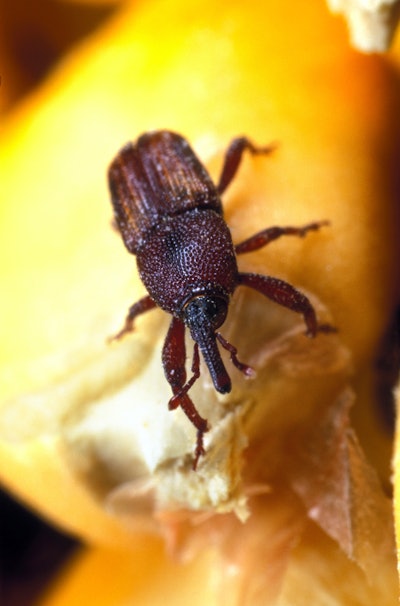
Effectively fumigating stored grain when insect levels rise to a population large enough to damage the product will most likely alleviate pest problems, but not without some concern.
That uncertainty is because under-dosing or inadequate sealing when using phosphine fumigant has led to phosphine resistance in some pests. When phosphine-resistant insects are known or suspected to infest stored grain, fumigation can be conducted with another fumigant — sulfuryl fluoride. No insects are known to be resistant to this fumigant, but with only two fumigants on the market, there is concern that if resistance grows, those with infestations might find themselves with serious problems.
To reduce the use of those fumigants, experts are advising grain storage operators develop integrated pest management programs. The idea is simple — reduce the probability that pests are present when grain is delivered and manage the grain in a way that keeps low the likelihood that if any pests present, they can reproduce and damage the grain.
“We store grain in big piles and open containers that aren’t very well sealed. Insects have no problems accessing that grain,” said Linda Mason, a professor of entomology at Purdue University. “They can decrease the quality, make it so that the grain can’t be sold because it is so contaminated, and then you lose all value from the grain. We’re trying to limit the growth at which those insects multiply and cause significant damage.”
Fumigation is part of that plan still. It’s just that it’s considered more of a last resort, especially for grain that isn’t stored very long.
“An integrated pest management strategy is a componentbased strategy,” said Frank Arthur, a research entomologist with the U.S. Department of Agriculture’s Agricultural Research Service.
“There are things you can do to perhaps limit the need to fumigate, but if you need to fumigate, then you must fumigate.”
Fumigation is also more expensive than other components of an integrated pest management plan, which can be effective if put into place with some forethought. Mason said the key thing is to have a plan laid out long before grain starts coming in for storage.
“You have to think preventive,” she said. “You have to think about those options before you get into the situation where you’re managing for insects.”
Sanitation
Unless a grain bin is airtight, insects are likely at some point to find a way inside. But grain bin operators can at least do themselves the favor of starting at zero, or pretty close to it.
Experts say probably the most important part of an integrated pest management plan is cleaning in and around a storage bin. Grain left from the last storage is likely to have insects feeding on it.
“You leave maybe a bushel scattered around that floor, and to us that’s nothing. But to an insect or rodent or bird, that’s huge. You can wind up with thousands of insects waiting, and when you put in new grain, they just move up into the new grain,” Mason said. “The insects are not in the field coming in at harvest. They’re already in our facility. If you can do something to keep the insects from where you’re putting the grain, like having a clean grain bin, then you’re decreasing your risk considerably.”
That cleaning may be especially important in areas that are difficult to see. John Mueller, a corporate manager with Food Protection Services, a Carmel, IN-based company that focuses on stored food protection, said ventilation ducts, particularly perforated ducts, fill with small particles of grain that are enticing to insects that can lay in wait for the next shipment of grain. After cleaning the bin, as well as ventilation areas, it should then be treated with a residual insecticide a couple weeks before the bin is filled.
“Those aeration tunnels have to be treated a little more heavily because they have fine particles that insects are feeding on,” Mueller said.
It’s best to have concrete or asphalt around the outside of a bin, but in any case, all spilled grain or weeds should also be cleaned up to decrease the risk of insects hanging out nearby.
“That spilled grain causes a lot of grain operation managers more trouble than they realize,” Mueller said.
Once grain is filled, Bhadriraju Subramanyam, the Wilbur Endowed Professor at Kansas State University whose research focuses on stored grain pests, said it’s important to keep the surface level.
“Do not peak the grain. They should level it near the eaves,” Subramanyam said. “It facilitates better gas distribution and better inspection.”
Treatment and temperature
Those concerned about infestations can also treat their grain with insecticides or insect growth regulators before putting it into storage. The treatment would kill the pests, or alter the life cycle or reproduction capabilities of insects that come into contact with the grain. Key consideration when considering a treatment is the length of that storage.
If the grain will be stored for a matter of weeks or a couple months, it’s unlikely that a treatment will be necessary. If grain will be stored for a longer period, throughout winter and into spring or the next summer, an insecticide treatment may be helpful.
“If I know I’m going to hold grain for three months or longer, I want to treat it,” said Richard Alford, national sales manager for Central Life Sciences, a Schaumburg, IL-based company. “Within that period, you’re not going to get a tremendous amount of insect growth. Beyond that period, even in cold weather, the bugs never die. They just go dormant. When you hit warm weather again, they become active and start multiplying, andthat’s when you get damage and start having loads rejected.”
Even without treating all grain, operators might consider coating the top of their bins with an insecticide that acts as a cap, which will kill insects before they can bore down into grain.
Cooling grain will also slow or stop insects. Once grain temperatures drop to 50 to 55 F or cooler, insects that damage grain stop growing and reproducing.
“Temperature management is probably an underutilized option,” Arthur said.
Cooler temperatures also inhibit the growth of molds that not only damage grain, but also attract other insects that feed on the molds.
Mason said one problem storage units sometimes have is that fine material collects in the middle of the grain, creating a more solid mass and impeding the flow of air. Grain in that mass tends to cool more slowly, allowing molds to grow and insects to multiply.
She suggests pulling fines from the core of a bin and spreading them over the top. If they are evenly distributed, the air will have to go through them rather than around as when they’re in the middle of the grain.
Testing and fumigation
Even with the most stringent cleaning and cooling regimen, insects are likely going to be in stored grain. Operators should test their grain often, especially after temperatures start to rise in the spring.
“The problem is that a lot of people don’t sample that frequently,” Subramanyam said.
The presence of insects isn’t necessarily a problem. But if during subsequent tests there are more insects, that could suggest that they are reproducing. Different operators will have different thresholds for an acceptable number of insects based on what their customers will allow. If insect populations start getting close to those thresholds, they might consider fumigating.
Mueller said in addition to counting insects, it helps to know which types are present. Certain insects which he calls the “dirty dozen” will be able to break open and damage grains. An additional three pests will consume mold, making up what Mueller calls the “filthy fifteen.” The presence of those insects in growing populations signals a problem.
“That’s when they would implement something like a fumigation or another type of alternative strategy,” Mueller said.
Bob Braun, a business development manager with Douglas Products, a pest-control company based in Liberty, MO, said some managers fumigate when grain is delivered to make sure they are starting off insect free, while others fumigate on a consistent schedule to maintain the value of the commodity. Some others wait to see if they reach or are nearing their thresholds, a practice that requires constant monitoring.
He suggests making sure grain is dry when fumigating to ensure grain is treated properly.
“If they get hot spots or wet spots inside, it doesn’t necessarily penetrate through the wetter grain in those heavier, denser areas of that grain mass,” Braun said. “You might not get full control throughout a bin.”
Braun added that his company has a fumigant calculator that is required as part of the labeling to be used with their sulfuryl fluoride fumigant ProFume®. Other fumigant companies also have specific directions. The calculator will give precise instructions for the amount of product needed and the hold time based on the size of the bin, the insects present and other factors. Following those directions will not only ensure insects are killed, but will also save money. Too little or too much fumigant can cause problems, he said.
“We want to prevent undershooting, which could lead to resistance or tolerance to a fumigant,” Braun said. “Also, you don’t overshoot and waste gas and money. You can only kill the bug once.”
It’s also important to know that organic grain cannot be fumigated. In cases of infestations, there are alternatives such as pumping different atmospheric gases through the bin to kill insects, though those techniques are costlier.
“It’s not a common practice, but we do use carbon dioxide on organic grain,” Mueller said.
At the end of the day, bin operators can do a lot to not only keep their grain safe from infestation, but also to reduce the likelihood of insects gaining resistance to the few fumigants available to those who need them.
“All these other pre-measures that aren’t insecticide based can help us save the few control strategies, the insecticides, that we do have,” Mason said.


















